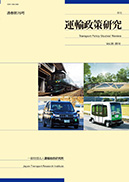Volume 13, Issue 2
Displaying 1-5 of 5 articles from this issue
- |<
- <
- 1
- >
- >|
Policy research paper
-
2010Volume 13Issue 2 Pages 002-013
Published: July 23, 2010
Released on J-STAGE: May 31, 2019
Download PDF (1605K)
Academic research paper
-
2010Volume 13Issue 2 Pages 014-023
Published: July 23, 2010
Released on J-STAGE: May 31, 2019
Download PDF (1072K)
Report
-
2010Volume 13Issue 2 Pages 024-032
Published: July 23, 2010
Released on J-STAGE: May 31, 2019
Download PDF (433K) -
2010Volume 13Issue 2 Pages 033-041
Published: July 23, 2010
Released on J-STAGE: May 31, 2019
Download PDF (1136K)
Updates and information
-
2010Volume 13Issue 2 Pages 042-048
Published: July 23, 2010
Released on J-STAGE: May 31, 2019
Download PDF (415K)
- |<
- <
- 1
- >
- >|
